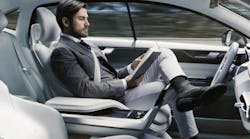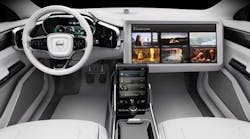At the 2016 Consumer Electronics Show (CES), Volvo revealed that it is developing intelligent, high-bandwidth, streaming capabilities with its technology partner, Ericsson, that will ensure drivers and passengers get the most out of their time traveling in an autonomous Volvo.
“We recently unveiled our design vision for fully autonomous cars with Concept 26. Now we are actively working on future solutions to deliver the best user experience in fully autonomous mode. Imagine a highway full of autonomous cars with their occupants sitting back watching their favorite TV shows in high-definition. This new way of commuting will demand new technology, and a much broader bandwidth to ensure a smooth and enjoyable experience,” says Anders Tylman, general manager, Volvo Monitoring & Concept Center, at Volvo Car Group.
Volvo Cars’ ongoing research into autonomous driving has confirmed what we all know—that the daily commute is taking the joy out of driving. It is during the commute and on long-haul motorway trips that people are most willing to delegate the act of driving to their car.
With this in mind, Volvo has developed Concept 26, named to reflect the average daily commute to work of 26 minutes—time that could be spent doing something more meaningful than sitting in stop-and-go traffic. Volvo has set out to bring choice and freedom back to the driver; to enjoy the driving experience when they want to, or to delegate driving to the car when they want to do something else.
Interruption-Free Media Streaming
Autonomous drive will bring a paradigm shift to mobile net demands. Volvo and Ericsson believe that this shift will see an increased need for consistent and high-bandwidth coverage outside densely populated areas such as city centers and suburbs.
Utilizing Ericsson’s network and cloud expertise, Volvo's aim is to deliver a high-quality, interruption-free experience in its cars while on the move. By predicting your route and looking ahead at network conditions, content can be tailored to the duration of each trip and intelligently buffered to deliver a high-quality and uninterrupted viewing experience.
“Our research shows that almost 70% of all mobile data traffic will be from video in the coming years. This requires an innovative connectivity, cloud, and analytics solution that is not only capable of serving multiple moving vehicles across a highway, but also has the capacity to provide the high-quality, uninterrupted video service today’s consumer is accustomed to,” says Claes Herlitz, head of automotive services at Ericsson.
By learning the most common routes and times of travel and understanding media preferences, future Volvo cars will be able to provide one-click navigation and a customized preference based list of potential media—allowing customers to choose routes and select content tailored to the amount of autonomous time that is available during their commute.
Personalized and Optimized Content
“If you want to watch the latest episode of your favorite series, the car will know how long the journey needs to take and can optimize the route and driving control accordingly. With autonomous drive, it is no longer just a question of just getting from A to B quickly—it’s about the experience you wish to have in the car, how you wish to spend the time you are saving.
“With our future autonomous drive technology, we will provide people with the freedom to choose the way they would like to commute and the content they would like to experience,” notes Volvo’s Tylman.
Drive, Create, Relax
“It’s all about people,” says Robin Page, vice president of interior design at Volvo Cars. “Our research clearly shows that some people will want to use their commuting time creatively when they have full autonomous drive available, while others will want to just sit back and relax, watch online media or listen to music. Autonomous drive will make all of this possible. This is what Concept 26 has captured by reimagining the entire car experience.”
Concept 26 is based around an all-new patented seat design that actively cradles the driver during the transformation phase into one of the three modes: Drive, Create, or Relax. With these three modes, the concept creates a new autonomous drive innovation platform that can adapt to new needs and technologies over time.
When the driver wishes to delegate driving to the car the steering-wheel retracts, the seat reclines and a large display emerges from the dashboard, allowing the driver to enjoy the time spent in the car as they like. Concept 26 embraces the need for radical change of the basic design of car interiors and provides a space that can be used as the driver/passenger wishes.
Concept 26 opens up a new paradigm of possibilities in the car—from entertainment to service provision and beyond, using the technology that is now a natural part of our everyday lives. It also signals the huge potential for new business opportunities and high-tech collaborations that autonomous drive will bring.
“We have gone to great lengths to understand the challenges and opportunities that autonomous cars will bring to people in coming years, and our flexible approach to engineering and design, enabled by our new Scalable Product Architecture, means that we can readily bring this from concept to reality,” says Dr. Peter Mertens, senior vice president, research and development at Volvo Car Group.
Volvo Cars’ ongoing Drive Me research project, which will see an extended fleet of fully autonomous cars driving real customers on the roads of Gothenburg, Sweden, in 2017 is further proof that Volvo is a leader in autonomous drive technology, building firmly on its foundation of safety.
“Volvo Cars is among the first to address the subject of self-driving cars and liability. We firmly believe that car makers should take full responsibility for the actions of the car when it is driving in full autonomous mode. If a manufacturer does not accept liability it clearly implies that they are not confident about their autonomous drive technology,” says Mertens.
About the Author

Sam Davis
Sam Davis was the editor-in-chief of Power Electronics Technology magazine and website that is now part of Electronic Design. He has 18 years experience in electronic engineering design and management, six years in public relations and 25 years as a trade press editor. He holds a BSEE from Case-Western Reserve University, and did graduate work at the same school and UCLA. Sam was the editor for PCIM, the predecessor to Power Electronics Technology, from 1984 to 2004. His engineering experience includes circuit and system design for Litton Systems, Bunker-Ramo, Rocketdyne, and Clevite Corporation.. Design tasks included analog circuits, display systems, power supplies, underwater ordnance systems, and test systems. He also served as a program manager for a Litton Systems Navy program.
Sam is the author of Computer Data Displays, a book published by Prentice-Hall in the U.S. and Japan in 1969. He is also a recipient of the Jesse Neal Award for trade press editorial excellence, and has one patent for naval ship construction that simplifies electronic system integration.
You can also check out his Power Electronics blog.

